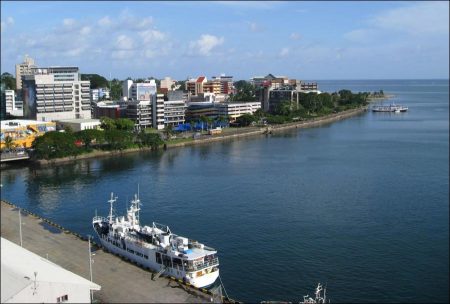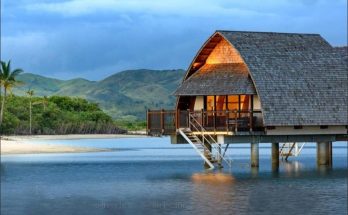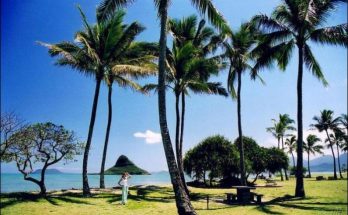Fiji, officially the Republic of Fiji, is an island country in Melanesia in the South Pacific Ocean about 1,100 nautical miles (2,000 km; 1,300 mi) northeast of New Zealand’s North Island. Its closest neighbours are Vanuatu to the west, New Caledonia to the southwest, New Zealand’s Kermadec Islands to the southeast, Tonga to the east, the Samoas and France’s Wallis and Futuna to the northeast, and Tuvalu to the north.
Fiji is an archipelago of more than 330 islands, of which 110 are permanently inhabited, and more than 500 islets, amounting to a total land area of about 18,300 square kilometres (7,100 sq mi). The farthest island is Ono-i-Lau. The two major islands, Viti Levu and Vanua Levu, account for 87% of the population of almost 860,000. The capital, Suva on Viti Levu, serves as Fiji’s principal port. About three-quarters of Fijians live on Viti Levu’s coasts, either in Suva or in smaller urban centres like Nadi (tourism) or Lautoka (sugar cane industry). Viti Levu’s interior is sparsely inhabited due to its terrain.
Sun-drenched beaches, turquoise lagoons, swaying palm trees – Fiji supplies all the classic images of paradise. No wonder, then, that every year thousands of travellers come to this South Pacific archipelago for the ultimate island escape. With over three hundred islands to choose from, Fiji is an amazingly versatile destination. Whether you’re after a luxury honeymoon retreat, a lively backpacker island or a family-friendly resort you won’t be disappointed. You’ll also find a warm, hospitable people, an intriguing blend of Melanesians, Polynesians and Indians.
With a reliable tropical climate, a good tourist infrastructure, English as its main language and no jabs or pills to worry about, travelling in Fiji is as easy as it gets. As the hub of South Pacific tourism, the country attracts over half a million visitors a year, mostly from Australia and New Zealand, its largest “neighbours” lying over 2000km southeast. Of the northern hemisphere travellers who arrive, many are backpackers from Europe or surfers and scuba divers from North America.
While it can be tempting to spend your whole time in Fiji sunbathing and sipping cocktails from coconuts, there are plenty of activities to lure you away from the beach. Within a ten-minute boat ride of most resorts you can find yourself snorkelling with dolphins and manta rays or scuba diving at pristine coral reefs. In addition, at the exposed edges of the reefs are some of the world’s finest and most consistent surfing breaks. Nature lovers are also spoilt for choice, both underwater and on dry land, and wildlife-spotting opportunities are plentiful, whether you’re seeking turtles, exotic birds or 3m-long tiger sharks.
Away from the resorts is another Fiji waiting to be discovered: a land of stunning mountains, rainforests and remote villages. Here you’ll find fantastically hospitable Fijians living a similar lifestyle to their tribal ancestors. Staying a night or two at a village homestay will give you an authentic insight into ethnic Fijian culture as well as the chance to sample yaqona or kava, the national drink.
Fiji is also home to a large Indian community and their influence is seen in the delicious Indian food served in almost every town, Bollywood films showing in the cinema and vibrant Hindu festivals celebrated throughout the year. While Fiji is not renowned for its towns or cities, three are definitely worth taking the time to explore: quaint, colonial-era Levuka, yachting hotspot Savusavu, and Suva, the lively capital city and the best place to party in the South Pacific.
However long you spend in the country you’ll notice an unhurried, good-humoured lifestyle. This is the essence of Fiji Time – an attitude that can be both inspiring and infuriating. Away from the highly organized upmarket resorts, life runs at a different pace; bus and ferry timetables serve more as guidelines and a simple meeting in a village can last for days. It’s best to leave your inner control freak at home – you never know, you may come back a calmer person.
Views: 214




